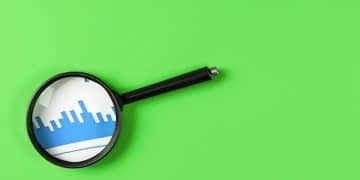Stagflation fears: understanding the looming economic threat

Stagflation refers to an economic condition combining stagnant growth, high inflation, and rising unemployment, making it challenging for consumers and businesses to maintain financial stability.
Stagflation fears are making headlines lately, and it’s important to understand what they mean for our economy. Have you noticed rising prices and stagnant wages? Let’s dive into the implications of this phenomenon.
What is stagflation and why does it matter?
Stagflation is a term that combines stagnation and inflation. It refers to a situation where the economy experiences stagnant growth, high unemployment, and rising prices. This combination can be troubling because it defies the typical relationship between inflation and employment. Understanding stagflation is crucial because it helps us recognize the signs and prepare for potential economic downturns.
Understanding Stagflation
To grasp the full impact of stagflation, we must explore its causes. It often arises from supply shocks, poor economic policies, and rising production costs. When essential goods become scarce, prices rise while economic growth falters.
The effects can be devastating. Consumers struggle as prices increase, and job opportunities vanish. As businesses cut back, the economy slows further.
Key Signs of Stagflation
- Rising consumer prices
- High unemployment rates
- Slow economic growth
Recognizing these signs early can aid in taking necessary actions. Policymakers must respond effectively to combat the negative effects of stagflation. This involves using various economic tools to manage inflation and stimulate growth.
In the 1970s, the world experienced a significant stagflation crisis, mainly due to oil price shocks. Lessons from this period highlight the importance of monitoring both inflation and growth to avoid similar crises in the future.
Historical examples of stagflation effects

Throughout history, there have been notable instances of stagflation that serve as warnings and learning opportunities. Understanding these examples can help us grasp the profound impacts of this economic condition.
The 1970s Oil Crisis
One of the most infamous cases occurred during the 1970s. The oil crisis, triggered by OPEC’s oil embargo, led to skyrocketing prices and economic turmoil. As oil became expensive, production costs soared, causing inflation while economic growth stalled.
Impact on Consumers
During this period, consumers faced rising prices on essential goods, making it hard to maintain their standard of living. Unemployment rates also climbed, as businesses struggled to cope with decreased demand and higher costs.
- Inflation hit over 13% at its peak.
- The unemployment rate rose to about 10%.
- Many households experienced financial hardship.
These statistics highlight how stagflation can create a cycle of negative impacts on both the economy and the lives of everyday people. The lessons learned from the 1970s still resonate today, reminding policymakers to remain vigilant against signs of this economic phenomenon.
The Japanese Experience in the 1990s
Another important example comes from Japan in the 1990s. Despite rapid growth in the 1980s, the economy faced stagnation as asset bubbles burst, leading to a prolonged period of stagnation coupled with low inflation.
This situation, often referred to as the “Lost Decade,” demonstrated how stagflation could evolve differently based on unique circumstances. Japan dealt with slow growth, persistent deflation, and underlying structural issues in its economy for years.
Such historical examples inform us about the complex nature of stagflation. Recognizing the challenges and responses in these instances can guide current economic strategies.
Current indicators of potential stagflation
Identifying the current indicators of potential stagflation is crucial for understanding how likely this economic condition may be in the near future. Analyzing various economic metrics offers insight into whether we are heading toward stagnation paired with rising inflation.
Key Economic Indicators
Several indicators can signal the onset of stagflation:
- Rising Inflation Rates: When the consumer price index increases, it means prices for goods and services are climbing.
- Employment Trends: If unemployment rates remain high while inflation rises, this can be a warning sign.
- Stagnant GDP Growth: A lack of economic growth over consecutive quarters can indicate underlying issues.
- Supply Chain Disruptions: Problems in global supply chains often lead to shortages and increased costs, driving inflation higher.
Monitoring these indicators can help analysts and policymakers gauge the likelihood of encountering stagflation. When inflation rises but economic growth remains sluggish, it creates a challenging environment for consumers and businesses alike.
The Role of Monetary Policy
Central banks play a significant role in managing inflation and promoting growth. However, raising interest rates to control inflation can sometimes slow down economic growth, creating a delicate balance. This situation may lead to fears of stagflation if not handled carefully.
Additionally, external factors such as global economic shifts or geopolitical tensions can also contribute to the potential for stagflation. Keeping a keen eye on both domestic and international trends is essential for predicting future economic conditions.
How stagflation impacts everyday consumers

The effects of stagflation are felt deeply by everyday consumers. As the economy experiences rising prices and stagnant growth, people face unique challenges.
Rising Costs of Living
One of the most immediate impacts is the sharp increase in the cost of living. Essentials like food, gas, and housing often see substantial price hikes. This means that even if wages remain the same, consumers have to spend more, resulting in less disposable income.
- Increased Prices: Items such as groceries become more expensive, forcing families to adjust their budgets.
- Energy Costs: Higher costs for heating and fuel can strain household finances.
- Less Savings: As everyday purchases increase, saving for future needs becomes difficult.
You might notice that your favorite products are now more expensive or that you’re stretching your budget further each month. This tightening can lead to stress and uncertainty.
Impact on Employment and Job Security
Another significant effect of stagflation is its influence on employment opportunities. As businesses struggle with rising costs and stagnant sales, they may cut back on hiring or even lay off workers. This creates a cycle where unemployment rises, and the job market becomes more competitive.
Consumers may find their job security increasingly threatened during such times. This uncertainty can lead to people hesitating to spend money, further slowing economic growth. When consumers hold back, it affects businesses, leading to more layoffs and closures.
Overall, a period of stagflation can make life more challenging for individuals and families. Understanding how these factors interact helps us navigate through tough economic times.
Strategies to navigate stagflation risks
Navigating the risks of stagflation can be challenging, but several strategies can help individuals and businesses adapt to this difficult economic environment. These strategies focus on both immediate and long-term actions to protect against the impacts of rising costs and stagnant growth.
Financial Planning and Budgeting
One of the most effective ways to combat stagflation is through careful financial planning. Creating a budget that accounts for rising prices can help households manage their expenses better. It’s important to track spending closely and adjust as needed.
- Reduce Unnecessary Spending: Identify non-essential items and cut back where possible.
- Build an Emergency Fund: Save a portion of income to prepare for unexpected financial difficulties.
- Shop Smart: Look for sales, use coupons, and compare prices to maximize purchasing power.
Implementing these budgeting techniques can provide more flexibility in adjusting to economic changes.
Investing Wisely
During a period of stagflation, the right investment strategies can also help protect wealth. Consider diversifying investments to help shield against inflation and market fluctuations. Certain assets, like real estate or commodities, often perform better during inflationary periods.
Some people find value in investing in stocks of companies with strong pricing power, which can pass on costs to consumers. Additionally, bonds can provide stability, though choosing the right type is important in an inflationary environment.
A well-thought-out investment plan can help navigate the ups and downs of the economy while safeguarding assets.
Staying Informed
Keeping up with economic news and trends can provide valuable insights into potential changes. Understanding indicators of stagflation can help individuals and businesses make timely decisions. By paying attention to inflation rates, employment figures, and other economic reports, consumers can better prepare for upcoming challenges.
Overall, developing a proactive approach to finance, investment, and awareness of economic conditions can significantly mitigate the impacts of stagflation. These strategies will help maintain financial stability even in uncertain times.
In summary, understanding stagflation and its impacts
Managing stagflation requires awareness of its effects on the economy and daily life. Consumers face rising costs, job insecurity, and financial stress. However, by adopting effective strategies like financial planning, wise investing, and staying informed, individuals can navigate these challenges more successfully.
Learning from past examples of stagflation helps us recognize the signs early on. By taking proactive steps now, we can protect our finances and ensure a more stable future.
Awareness, adaptability, and smart decision-making will be key in overcoming the potential risks of stagflation.
FAQ – Frequently Asked Questions about Stagflation and Its Impact
What is stagflation and why is it a concern?
Stagflation is a combination of stagnant economic growth, high unemployment, and rising prices. It is concerning because it creates a tough environment for consumers and businesses.
How does stagflation affect everyday consumers?
Stagflation increases the cost of living, leading to higher prices for essentials while wages may not keep up, reducing disposable income and causing financial stress.
What strategies can individuals use to navigate stagflation risks?
Individuals can manage stagflation by creating a budget, investing wisely, and staying informed about economic conditions to make proactive financial decisions.
What historical examples illustrate the effects of stagflation?
The 1970s oil crisis and Japan’s lost decade in the 1990s are key examples. They highlight how rising prices and economic stagnation impact consumers and the economy.





